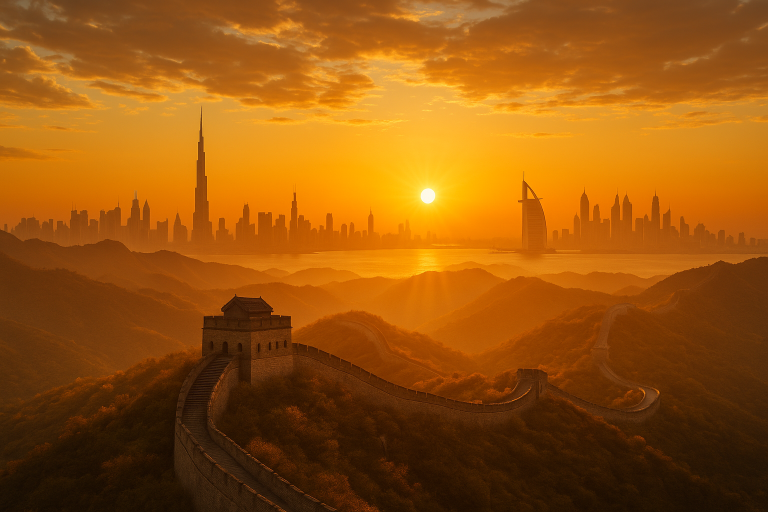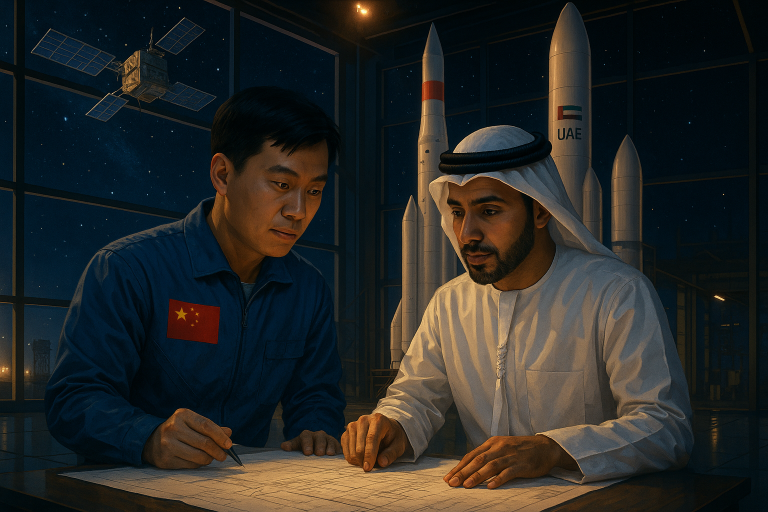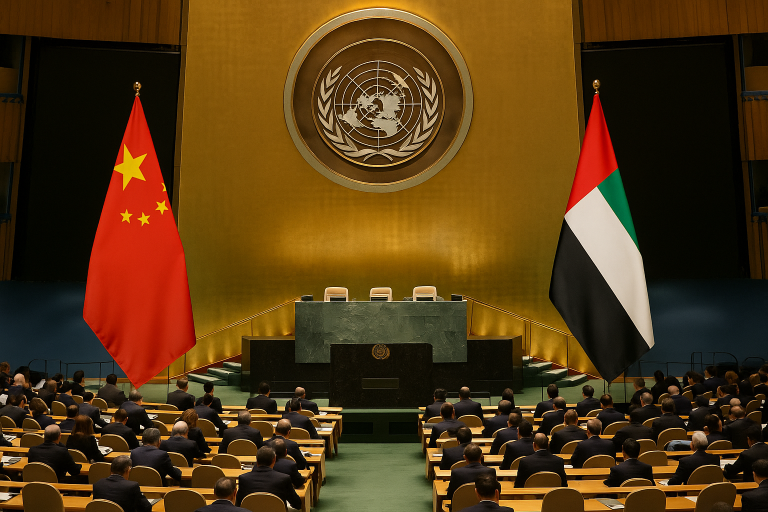Investing in Tomorrow: Cultivating the Next Generation of China-UAE Leaders
Introduction
In a sunlit classroom in Abu Dhabi, a young Emirati student confidently traces the intricate strokes of a Chinese character on a smartboard, her classmates offering encouragement in fluent Mandarin. Across the world, in a state-of-the-art laboratory at a university in Beijing, a group of Chinese and Emirati engineering students huddle together, collaborating on a robotics project. These seemingly small moments are, in fact, the powerful and living embodiment of the most forward-looking and arguably the most valuable investment within the China-UAE Comprehensive Strategic Partnership. This is an investment not in concrete and steel, but in minds and friendships. It is a deep and growing commitment to education and youth exchange, a strategic endeavor dedicated to cultivating a new generation of leaders who will be the natural custodians, the passionate advocates, and the future architects of this vital bilateral relationship. This article explores the key pillars of this profound investment in human capital, from the landmark language-learning initiatives that are breaking down barriers to the expanding network of higher education collaboration that is building a shared intellectual future.
The Language of Friendship: The Mandarin Program in UAE Schools
One of the most visionary and impactful initiatives within the entire China-UAE partnership is the nationwide program to teach the Chinese language (Mandarin) in the UAE’s public schools. Launched by the UAE Ministry of Education, this ambitious project is a testament to the nation’s long-term strategic thinking. It correctly identifies that true, deep, and sustainable partnership in the 21st century requires a common language, and it is investing today to give the next generation the tools they will need for the world of tomorrow.
The program, which aims to include as many as 200 schools, is already having a profound impact on thousands of young Emirati students. It provides them with a unique and highly valuable skill set that will open up a world of opportunity in their future careers, whether in diplomacy, business, technology, or the arts. More than that, it provides a direct and unfiltered window into one of the world’s oldest and richest cultures. The program is carefully designed to go far beyond rote memorization. It employs native-speaking teachers, utilizes modern, interactive technology, and incorporates a rich array of cultural activities, from calligraphy and traditional music to celebrations of Chinese festivals. This holistic approach makes the process of learning the language engaging and fun, and it ensures that students are not just learning words, but are gaining a genuine appreciation for the culture and people behind the language.
By starting this process at a young age, the UAE is embedding a deep-seated familiarity and comfort with Chinese culture into its national DNA. The students in these classrooms today will be the leaders of the UAE in the 2040s and 2050s. For them, China will not be a distant and unfamiliar land; it will be a place whose language they can speak and whose culture they can understand. This shared foundation will make future collaboration more natural, more intuitive, and ultimately, more successful.
The Higher Education Bridge: Universities and Scholars
This investment in human capital extends into the highest levels of academia, where a vibrant and rapidly expanding bridge of collaboration is being built between the leading universities of the UAE and China. This is a partnership of intellectual equals, bringing together some of the world’s top minds to tackle shared challenges and push the boundaries of scientific and technological knowledge. Esteemed institutions in the UAE, such as Khalifa University, United Arab Emirates University, and the Mohamed bin Zayed University of Artificial Intelligence (MBZUAI), have forged deep and active partnerships with China’s elite C9 League universities, including Tsinghua University and Peking University.
The focus of these collaborations is squarely on the future. They are centered on joint research and development in the most critical high-tech fields of our time. Emirati and Chinese scientists are working together in shared labs on projects in Artificial Intelligence, renewable energy, space science, biotechnology, and advanced materials. This pooling of intellectual resources, backed by significant investment from both sides, is accelerating the pace of innovation and generating new knowledge and intellectual property that will have far-reaching benefits for both nations and the world.
These partnerships are also creating a two-way superhighway for talent. Student exchange programs are giving hundreds of students the life-changing opportunity to spend a semester or a full academic year immersed in the culture of the other country. Prestigious scholarship programs, such as the Sheikh Mohamed bin Zayed Scholarship for Exceptional Emirati Students in China, are enabling the brightest young minds from the UAE to pursue full degrees at China’s top universities. These students return home not only with a world-class education but with a global perspective, a network of international friends, and a deep understanding of modern China that is impossible to gain from a textbook. This academic bridge is further strengthened by the presence of Confucius Institutes in the UAE, which serve as dynamic centers for language learning and cultural outreach, making Chinese culture accessible to the entire community.
Cultivating Future Leaders: Youth Dialogues and Programs
Recognizing that leadership and friendship are often forged outside the classroom, both countries have placed a strong emphasis on programs that bring their young people together for shared experiences. These initiatives are designed to foster leadership skills, encourage cross-cultural dialogue, and, most importantly, build the lasting personal connections that are the bedrock of international partnership.
A flagship initiative in this area is the UAE-China Youth Dialogue. This high-level platform regularly brings together delegations of the most promising aspiring leaders from both countries—young professionals, entrepreneurs, civil servants, and academics. Over several days of intensive workshops, discussions, and cultural activities, these young leaders debate critical global issues, from climate change and public health to the future of technology and education. They share their unique perspectives, challenge each other’s assumptions, and, in the process, build a powerful sense of shared purpose and mutual respect. They leave the dialogue not just with new ideas, but with a new network of friends and future counterparts.
This is complemented by a growing number of internship and young professionals programs. With the active support of the UAE China Chamber of Commerce (UECN), leading companies in both countries are offering valuable internship placements that allow recent graduates to gain hands-on professional experience in an international environment. These programs are a crucial bridge between university and the workplace, equipping young people with the cross-cultural communication skills and practical knowledge they need to succeed in the globalized economy. The “soft power” of youth exchanges in sports and the arts also plays a vital role, building camaraderie and friendship through the universal languages of competition and creativity.
The Future: A Generation of Natural Partners
The long-term return on this comprehensive investment in youth and education is immeasurable. The young people who are participating in these language classes, exchange programs, and youth dialogues today will be the diplomats, ministers, CEOs, scientists, and artists who will shape the world of the 2040s and 2050s. For this future generation of leaders, collaboration between the UAE and China will not be a strategic option to be debated; it will be a natural, intuitive, and deeply embedded instinct. They will have grown up speaking each other’s languages, studying in each other’s universities, and working alongside each other. The personal friendships and professional networks they are building today, sustained and nurtured by the constant connectivity of social media and digital platforms, will form a permanent, informal infrastructure of goodwill and trust.
Conclusion: The Most Enduring Legacy
In the grand narrative of the China-UAE Comprehensive Strategic Partnership, it is the shared commitment to cultivating the next generation that may prove to be the most enduring and impactful legacy. While the physical infrastructure of ports and railways connects the two nations today, it is the “human infrastructure” of shared knowledge, cultural fluency, and personal relationships that will bind them together for the century to come. The ultimate success of this remarkable partnership will be measured not just in trade volumes or diplomatic agreements, but in the strength of the friendships and the depth of the understanding shared by the next generation. By investing so profoundly in their youth, the UAE and China are ensuring that the golden era of their relationship is not a fleeting moment, but the dawn of a long and brilliant future of even greater collaboration and shared prosperity.







